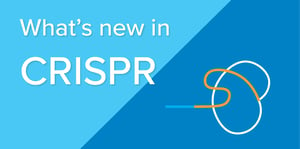 In this quarterly blog series, we’ll highlight a few of the new CRISPR plasmids available at Addgene. We will still periodically focus on specific CRISPR plasmid tools more in-depth (such as these recent blog posts on prime editing, IgnaviCas9, and Nanoblades), but we hope that this blog series will help you find more new CRISPR tools for your research!
In this quarterly blog series, we’ll highlight a few of the new CRISPR plasmids available at Addgene. We will still periodically focus on specific CRISPR plasmid tools more in-depth (such as these recent blog posts on prime editing, IgnaviCas9, and Nanoblades), but we hope that this blog series will help you find more new CRISPR tools for your research!
This time:
- CRISPRi in Burkholderia
- Base editors
- CRISPR toolkit for epitope tagging
- Lentiviral capsid-based Cas9/gRNA ribonucleoprotein delivery
- Cytosine deaminase for RNA editing
CRISPRi toolkit for Burkholderia
Silvia Cardona’s lab recently developed a CRISPRi toolkit for Burkholderia, a genus of bacteria that can cause disease in humans. Expression of this system is tunable via a rhamnose-inducible promoter. While this system was optimized for Burkholderia, they identified 67 genera of Proteobacteria that this toolkit might be used in.
- Read the paper in ACS Synthetic Biology
- Find the CRISPRi toolkit
SECURE adenine base editor
Earlier this year, Keith Joung’s lab developed SECURE cytosine base editors, which decrease the rate of off-target genome edits compared to rat APOBEC1. Now, they’ve engineered SECURE adenine base editor variants using a protein-truncation strategy with reduced RNA-recognition capabilities.
- Read the paper in Nature Biotechnology
- Find the base editors
Single base editor that induces C-to-T and A-to-G mutations
Nozomu Yachie’s lab recently developed a base editor that combines the abilities of C-to-T and A-to-G base editors into one protein. They fused an activation-induced cytidine deaminase (AID) and an engineered tRNA adenosine deaminase (TadA) to a catalytically impaired Streptococcus pyogenes Cas9. They called this editor Target-ACE (adenine and cytosine editor). Target-ACE exhibits increased editing efficiency of a target site compared to a mixture of two base editor enzymes in mammalian cells.
- Read the paper in bioRxiv
- Find Target-ACE
CRISPR/Cas9-based toolkit for epitope tagging in neurons
Harold MacGillavry’s lab developed a CRISPR-based toolkit for targeted genomic integration of fluorescent tags in neurons. Their toolkit named ORANGE (Open Resource for the Application of Neuronal Genome Editing) mediates targeted genomic integration of fluorescent tags in neurons.
- Read the paper in bioRxiv
- Find the ORANGE toolkit
Cas9/gRNA ribonucleoprotein delivery by lentiviral capsid-based bionanoparticle
Transient expression of CRISPR/Cas9 in cells has advantages like reduced off-target activity and decreased immune response to Cas9. Recently, Baisong Lu’s lab developed a lentiviral capsid-based bionanoparticle system for packaging Cas9/gRNA ribonucleoproteins for transient expression. They replaced the tetraloop of the sgRNA scaffold with a com aptamer which binds an aptamer binding protein for packaging into a lentivirus-like particle.
- Read the paper in Nucleic Acids Research
- Find the gRNA and packaging plasmids
Cytosine deaminase for RNA editing
Feng Zhang’s lab previously developed a programmable adenosine-to-inosine (A-to-I) RNA editor called REPAIR by fusing catalytically inactivated RNA-targeting Cas13 (dCas13) with the adenine deaminase domain of ADAR2. Now, they’ve further developed this editor for C-to-U editing by evolving the adenine deaminase domain of ADAR2 into a cytidine deaminase. This editor still retains A-to-I editing. This system is called RNA Editing for Specific C-to-U Exchange, or RESCUE.
- Read the paper in Science
- Find RESCUE plasmids
If you have a new CRISPR tool you’ve recently deposited to Addgene and you’d like it to be included in the next What’s New in CRISPR blog post, please let us know. We also welcome blog posts from guest bloggers. Check out this blog post for more information.
Additional resources on the Addgene blog
- Download the CRISPR 101 eBook
- Find our CRISPR 101 blog posts
- Read our CRISPR cheat sheet
Resources on Addgene.org
- Read our CRISPR guide
- Find CRISPR plasmids by function
- Find recently deposited plasmids
Topics: CRISPR, Other CRISPR Tools






Leave a Comment